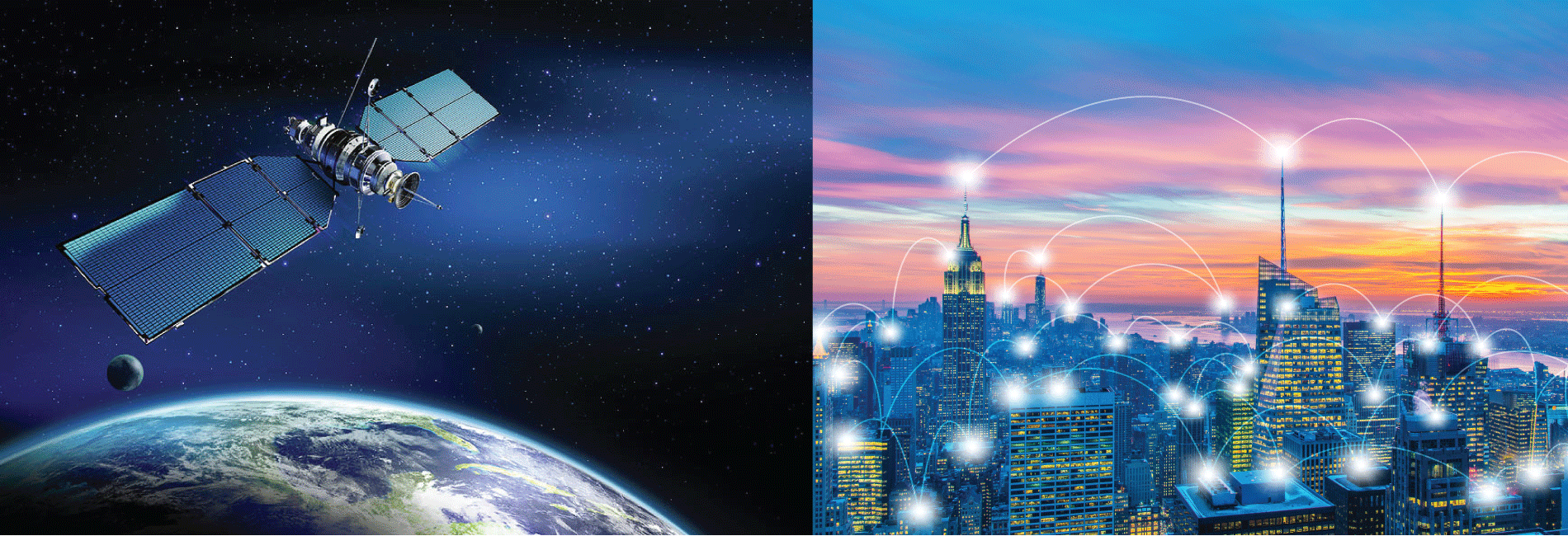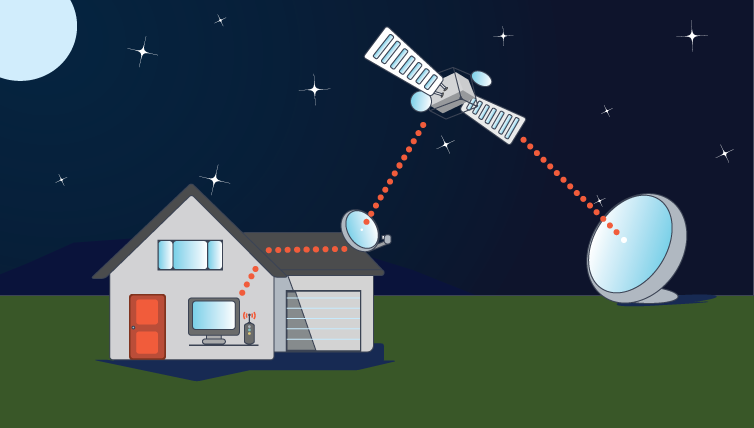Clearing the Confusion of Satellite Internet and Fixed Wireless

With the advancement of technology, there are many ways to connect to the internet. Gone are the days when we had to tie up a phone line to surf the web. Even coaxial cable is slowly becoming obsolete. We are now entering 2020, a new decade with new and exciting ways to stay connected on a worldwide scale. The new advances come through the use of Fixed Wireless and Satellite Internet services. However, they do differ, not only in how their connection is sent but in the reliability of their networks.
How Internet Connectivity Works
All internet companies begin with a Distribution Point. This is the location where the company’s signal originates. It is a physical structure that links the world’s databases together. Where the Internet Service Providers (ISPs) differ is in how they disseminate their connection to their customers. Some connect homes through a wired connection. This can include telephone, Ethernet, or coaxial cables. These lines run from the Distribution Point, to a local Access Point, then to the surrounding neighborhoods.
This method is difficult because there are so many homes in the United States, and the company can’t lay the wire to each and every one of them. This process is called provisioning. When you hear about an area not being provisioned, it simply means that the lines that offer service are not laid in the area. Once they are laid, anyone with a subscription to a provider can connect through those lines. Meaning if your area offers 2 service providers, they are all using the same lines.
There are other difficulties that plague underground cable infrastructure. Like Construction crews cutting existing cabling, cable deterioration over time due to aging underground infrastructure caused by underground events such as fires, storms, salt and water seeping into the cables, water main breaks and steam pipe explosions. All these events contribute to a decline and deterioration of the cabling, making it less effective and in turn losing much of the its capability to perform well.
However, there are easier ways of giving a home or business access to the world wide web; Fixed Wireless Services. But first let’s discuss the difference between Fixed Wireless and Satellite. There is confusion about the differences between these kinds of services and generally they are thought of to be the same, but they are not.

What is Satellite Internet?
As you may already assume, satellite internet is received through connecting to an orbiting satellite. The process involves transmitting signals from a dish to an orbiting satellite 22,300 miles above the Earth’s atmosphere. After the signal is received, it is beamed back to the ISP’s Network Operations Center (NOC) which is connected to the Internet. Then the signal is transmitted to your access point usually receivers like a home satellite dish. Then the cord runs from the Access Point to a Modem then to your computers through either wired connections or Wi-Fi services you have set up in your home. This method and significant travel time open the door to interference and compromised service.
Weather Affects the service greatly – Due to the fact that satellite signals travel up though the atmosphere and back, Weather conditions affect satellite internet more than they do fixed wireless. That means a storm in the next state can cause service problems.
Slow Lag Time or High Latency – Lag time, or latency, is the time for the signal to be transmitted back and forth. Because the satellite is positioned much farther from the receiver on your house than the wireless base station, satellite internet suffers from high latency (meaning long times between sending and receiving data). This can make even a high-speed connection sluggish and has a big impact on things like online gaming and streaming video.
Data Caps – A major issue when employing satellite technology is that many service providers enforce data caps. Using too much data will result in penalties in the form of restricted speeds or over-usage charges. For a business requiring a stable connection, the risk of throttled bandwidth or additional costs is not an option.
High prices – The biggest comparison is the one that can make all the difference – price. Fixed wireless remains cheaper to set up and to operate. Satellite service providers often demand a longer-term agreement with higher monthly charges.
Slow Installation cost and time – There obviously has to be an orbiting satellite in order to use the service. Which takes time, planning and financial resources. Ultimately being paid for by the customer.
What is Fixed Wireless?
Fixed Wireless is different in that the signal originating from the Distribution Point is not aimed at satellites in space. Rather, they are directed toward Access Points affixed to locations like cell towers and on top of a buildings antenna array that are between the Distribution Point and the customer. Fixed wireless utilizes radio links to connect two fixed points – the service provider’s tower, also known as a Point-of-Presence (PoP) with a building. Fixed wireless towers are land-based and are no taller than cell service towers minimizing the opportunity for atmospheric disruption. The customer has a receiver, often an antenna that is affixed to the home or building.

Weather doesn’t affect fixed wireless – Weather conditions don’t affect fixed wireless like they do satellite internet, because a base station used for fixed wireless internet is about as tall as an average cell phone tower. It’s usually located within 10 miles of your house, so the clouds above it and the storm that’s miles away won’t interfere with the signal it’s transmitting.
Low Latency – There is virtually no lag time with fixed wireless. A fixed wireless signal only travels between the receiver and the nearest tower – often fewer than 10 miles apart. The reduced distance is reflected with reduced latency and a superior connection.
No Data Caps – Fixed wireless providers are able to be transparent with their service. Unlike traditional cellular services, fixed wireless internet usually has either very high caps (100GB or more) or no caps at all. Additionally, the technology offers high download speeds that are just as fast if not faster than those you get from other broadband services.
More Reliable bandwidth – The lack of a data cap means customers can make the most of reliable bandwidth to use a VoIP phone system, upload and download data at rapid speeds, stream music and videos, and use any Internet-based applications safely with the knowledge there will be no extra charge to follow.
Fast Installation cost and time – There is little cost and time put into fixed wireless hardware and installation. This enables fixed wireless companies the ability to keep cost low for their customers. It’s easier to set up the equipment needed for fixed wireless internet than it is for other broadband services, because it doesn’t require physical cables or the hassle they entail.
Better Pricing – With less cost to setup and better quality of service fixed wireless providers can pass the savings on to their customers and keep pricing low.
Which is More Reliable: Satellite or Fixed Wireless?
Misconception 1: A Fixed Wireless connection is unreliable.
While it is true that a Fixed Wireless connection relies on line-of-sight communication between the Access Point and the receiver, connectivity has improved as signal strength has advanced. This includes improved connection during inclement weather, through brush and trees, and for the most part around other structures.
Misconception 2: A Fixed Wireless connection is slow.
A fixed wireless connection works by sending radio waves from the Access Point, which is usually on top of a cell tower, or building antenna array to the antenna receiver in the customer’s home. It works in the same fashion as a cell service. It has been proven that connectivity is faster cable lines.
Misconception 3: There is no difference between Satellite and Fixed Wireless service.
This is untrue in that the signal from a satellite provider must be sent into space, sent back and then to your dish or antennae. A Fixed Wireless signal never leaves the atmosphere. Since it is closer to the ground, you experience significantly lower latency, which is the lag time your connection experiences. Satellite also enforces strict data caps that Fixed Wireless does not have.

GiGstreem for Your Home or Business
GiGstreem offers a Fixed Wireless internet connection. Our Access Points are scattered through New York, Maryland, South Carolina, Florida, and DC/Virginia, giving residents and business owners the assurance of strong and reliable internet experience. The major benefits of GiGstreem over other ISPs is that we offer a symmetrical connection, we have no data caps, and we do not make you sign a long-term contract.
We are also upfront with our pricing. There will never be surprise charges for something you did not order because we do not force you into a bundled package. You pay for what you want at a price you can afford. With internet speed up to 10GiG, we have the internet speed to suit your needs.
Interested in service? Check the availability here. If you have any questions about Fixed Wireless services, you can email [email protected]. Our service agents are ready to assist you.